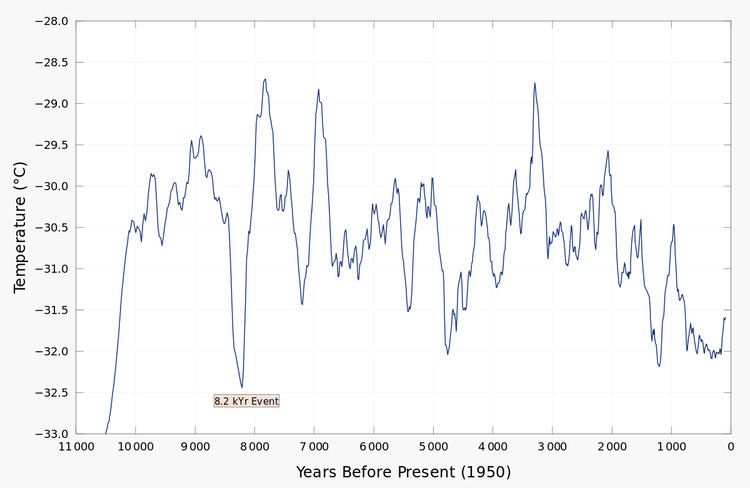 | ||
The 4.2 kiloyear BP aridification event was one of the most severe climatic events of the Holocene period. Starting in about 2200 BC, it probably lasted the entire 22nd century BC. The drought may have initiated southeastward habitat tracking within the Indus Valley Civilization.
Contents
The 4.2 kiloyear BP event has been hypothesised to have caused the collapse of the Old Kingdom in Egypt as well as the Akkadian Empire in Mesopotamia, and the Liangzhu culture in the lower Yangtze River area. However, this theory has been criticised by archaeologists, with political causes for the collapse of these polities thought to be more probable.
Evidence
A phase of intense aridity about 4.2 ka BP is recorded across North Africa, the Middle East, the Red Sea, the Arabian peninsula, the Indian subcontinent, and midcontinental North America. Glaciers throughout the mountain ranges of western Canada advanced at about this time. Evidence has also been found in an Italian cave flowstone, the Kilimanjaro Ice sheet, and in Andean glacier ice. The onset of the aridification in Mesopotamia about 4100 BP also coincided with a cooling event in the North Atlantic, known as Bond event 3. Despite this, evidence for the 4.2 kyr event in northern Europe is ambiguous, suggesting the origin and impact of this event is spatially complex.
Ancient Egypt
In c. 2150 BC the Old Kingdom was hit by a series of exceptionally low Nile floods. It has been suggested that this may have impacted the collapse of the centralised government in ancient Egypt at this time. Contemporary texts claim that famines, social disorder, and fragmentation subsequently occurred. There may however be a strong element of political bias to these writings, since the Egyptian elite believed the stability of Egypt was dependant on a unified state, and would have been motivated to present decentralisation as disastrous. After a phase of rehabilitation and restoration of order in various provinces, Egypt was eventually reunified within a new paradigm of kingship. The process of recovery depended on capable provincial administrators, a more formalised justice system, irrigation projects, and an administrative reform.
Mesopotamia
The aridification of Mesopotamia may have been related to the onset of cooler sea surface temperatures in the North Atlantic (Bond event 3), as analysis of the modern instrumental record shows that large (50%) interannual reductions in Mesopotamian water supply result when subpolar northwest Atlantic sea surface temperatures are anomalously cool. The headwaters of the Tigris and Euphrates Rivers are fed by elevation-induced capture of winter Mediterranean rainfall.
The Akkadian Empire in 2300 BC was the second civilization to subsume independent societies into a single state (the first being ancient Egypt at around 3100 BC). It has been claimed that the collapse of the state was influenced by a wide-ranging, centuries-long drought. Archaeological evidence documents widespread abandonment of the agricultural plains of northern Mesopotamia and dramatic influxes of refugees into southern Mesopotamia around 2170 BC. A 180-km-long wall, the "Repeller of the Amorites," was built across central Mesopotamia to stem nomadic incursions to the south. Around 2150 BC, the Gutian people, who originally inhabited the Zagros Mountains, defeated the demoralized Akkadian army, took Akkad, and destroyed it around 2115 BC. Widespread agricultural change in the Near East is visible at the end of the third millennium BC.
Resettlement of the northern plains by smaller sedentary populations occurred near 1900 BC, three centuries after the collapse.
Arabian peninsula
In the Persian Gulf region, there is a sudden change in settlement pattern, style of pottery and tombs at this time. The 22nd century BC drought marks the end of the Umm an-Nar Culture and the change to the Wadi Suq period.
Spain
On the Iberian peninsula, the construction of Motillas type settlements in the period after 2200 BCE is believed to be the consequence of severe aridification that affected this area.
According to Moreno et al., who reported the first palaeohydrogeological interdisciplinary research in La Mancha, Spain,
"Recent studies show that the "motilla" sites from the Bronze Age in La Mancha may be the most ancient system of groundwater collection in the Iberian Peninsula. ... These were built during the Climatic Event 4.2 ka cal BP in a time of environmental stress due to a period of severe, prolonged drought."
The authors' analysis verified a relationship between the geological substrate and the spatial distribution of the "motillas".
China
The drought may have caused the collapse of Neolithic Cultures around Central China during the late third millennium BC. At the same time, the middle reaches of the Yellow River saw a series of extraordinary floods. In the Yishu River Basin, the flourishing Longshan culture was hit by a cooling that made the paddies shortfall in output or even no seeds were gathered. The scarcity in natural resource led to substantial decrease in population and subsequent drop in archaeological sites. About 4000 years BP Longshan was displaced by the Yueshi culture which was relatively underdeveloped.
